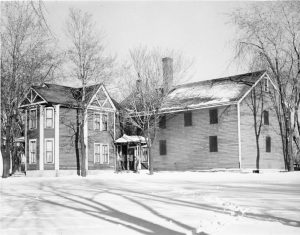
The Schoolcraft County Jail (right) and Sheriff’s residence (left) are pictured here in the 1950’s. SCHS photo, Marcus Bosanic Collection.
During the 1870’s Schoolcraft County was much larger than it is today, extending from Lake Michigan all the way to Lake Superior. Onota (in present day Alger County) was the county seat. But Onota’s days were numbered, as the entire town was destroyed by a great fire in 1879. After that disaster, the county seat of Schoolcraft County was relocated to Manistique.
John Costello was the first person to hold the office of Sheriff in the new county seat of Manistique, serving from 1879 through 1881. He was followed in office by John McCanna with his term as sheriff beginning in 1882.
The county’s first jail was a one-story wooden structure, 25 feet by 45 feet. It was heated by a wood furnace with ventilating flues in each cell. There were five cells made from wood plank, with a separate room to accommodate a bath tub and privy. This jail was totally destroyed by fire on January 25, 1884. Without a building to incarcerate prisoners, County Sheriff John McCanna’s only recourse was to release minor offenders. Persons charged with more serious offenses were transported to the Mackinac County Jail in St. Ignace. The journey took place by boat, as railroads had not yet reached Manistique.
In the fall of 1884 voters approved the construction of a new jail which opened in 1885. The new lockup was a two-story structure measuring 18 feet by 24 feet. There were six jail cells on the first floor. The 6 by 5 ½ foot cells were constructed with iron bars while the floor, ceiling and outside walls were made with wooden planks. Heat was provided in the winter by a wood stove in the corridor. Toilet facilities consisted of a bucket in each cell. Five small rooms on the second story housed female prisoners and boys. These were also used for the mentally ill while awaiting transport to the Northern Michigan Asylum in Traverse City. This jail served the citizens of Schoolcraft County until 1958 when it was replaced by our current jail building. A report to the County Board of Supervisors in September of 1889 revealed the vast majority of the 65 inmates housed at the jail during the previous six months were charged with being disorderly persons. More serious offenses that were noted included breaking and entering into dwellings, keeping a house of ill fame and rape.

John McCanna, Sheriff of Schoolcraft County (1882-1885). Photo Courtesy of Sue Cucchiarella.
A report by an inspector for the Michigan State Board of Corrections and Charities after a visit in September of 1895 noted that the facility had separate confinement for female and juvenile prisoners. Toilet facilities had been upgraded to include water closets with drawers which were removed from the outside and emptied. A bath tub had been provided for the inmates since the inspector’s previous visit. Wire screen guards were in place over the windows “to prevent the passing in of tools.” The inspector criticized the reuse of the iron cell blocks from the jail that burned, stating that new ones would have been far preferable. Although the conditions noted above sound extremely primitive by today’s standards, the inspector commented that the Schoolcraft County Jail was “one of the cleanest and well ordered jails in my district.”
This jail served the residents of Schoolcraft County for 72 years with Charles Lander winning the contract for the old lockup’s demolition in 1957-58. Manistique historian, Jack Orr, looked back on this event in his Memories column of January 28, 1982. He noted that the outside walls of the jail were constructed with 2” by 10” wooden planks nailed flat, one on top of the other, creating a solid 10 inch barrier of pine to the outside. The planks were nailed together with hand forged square spikes weighing three spikes to the pound. The floor and first floor ceiling were made the same way, with the exception that the planks were placed on edge and nailed together. The outside walls supported the ceiling. There were two sets of cell blocks, three 6 foot square cells to each unit. These were made of steel and were placed on each side of a central hallway. The cell blocks weighed 3 ½ tons each. All the window were secured with steel bars covered with a steel mesh. The upper floor of the jail consisted of small rooms used to incarcerate women.
To learn about the historical society’s new museum fund drive, see the “About Us” page on our website at https/schs.cityofmanistique.org/about-us/. Our mailing address is SCHS, P.O. Box 284, Manistique, MI. 49854.
